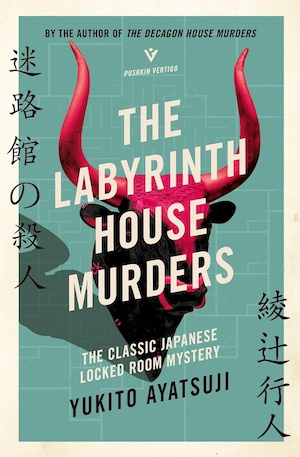
Translated by Ho-Ling Wong — The winner of three national awards for mystery writing in Japan, Yukito Ayatsuji is one of the country’s most famous authors who favours the traditional Honkaku mystery format. His Bizarre House Mysteries began in 1987 with The Decagon House Murders and The Labyrinth House Murders, originally published the following year, is the third of the nine books in the set, each taking place in an unusual mansion. Like Golden Age authors in the West, the author adheres to rules of fair play, notably giving the necessary clues so that the reader can compete with the detective in solving the mystery.
No doubt Christie, Chandler, Sayers, Hammett and their brethren would be quite comfortable reading the story of the doings in the Labyrinth House – the title itself suggests a complicated story to come. Those classic rules also suggest a story should emphasise plot and not get bogged down with lengthy descriptions or character analyses.
Prominent Japanese mystery writer Miyagaki Yōtarō is gravely ill and meets with his editor Utayama Hideyuki (last names first) at what had been his rural summer home, to which he’s now retreated full-time. Nevertheless, he is looking forward to his 60th birthday on 1 April and plans a little celebration involving some of the more talented young writers he has mentored plus an odd character, mystery fan Shimada Kiyoshi, he picked up along the way.
The young writers assemble, along with Shimada, Utayama and his wife, Keiko, a literary critic, and the housekeeper. A decade earlier, Miyagaki had the house built by eccentric architect Nakamura Seiji, and new arrivals learn that the actual house is underground, constructed as a giant labyrinth and you can see the map as you page through the book. Private rooms are ranged along the east and west sides with common areas at the north and south. Each room is named for one of the mythological characters connected with the Minotaur of Greek mythology.
Also awaiting them is Miyagaki’s secretary with the astonishing revelation that their host, dying of cancer, has committed suicide. They see the body, and in its presence listen to a recorded message that asks them not to call the police for five days and not to try to leave. Miyagaki’s posthumous instructions also ask the four writers to use the days to write the best detective story they can, which Utayama and Shimada will judge. The winner will receive half of Miyagaki’s very considerable estate. Initially nonplussed by these bizarre instructions, the writers soon rally and commit to the project.
Thus, you have a classic locked-room mystery. It doesn’t take much on a reader’s part to guess that the partygoers will begin dropping like flies. The first to die is found practically decapitated in the Drawing Room with their head replaced by that of a bull – a stuffed ornament that once adorned the wall.
Utayama and Shimada take the lead in pursuing an investigation, but neither can be sure that the other isn’t the mysterious killer. Most upsetting is that the positioning of each body and the cause of death mimics the draft story they were working on. This may lead you to believe that the author has violated another rule of the Golden Age, which says that a story could not contain any paranormal activity. At times, it may seem difficult to ascribe events to any other source. Conveniently, Utayama’s wife Keiko is a physician, so can offer some practical advice and diagnostic skills to the problems the guests encounter.
Thinking back on the experience of reading this book, I believe I learned less about Japanese culture than I might have expected and quite a bit more about the personalities of ambitious authors than I might have wanted. The character Miyagaki understood what he was dealing with when he set up this unusual challenge. Plus, the author Yukito Ayatsuji describes the labyrinth so precisely that between his descriptions of the action and the map, I was never confused.
Each murder necessitates a lengthy deconstruction of the surrounding events, the location of other guests at the probable time of the crime, and the relation to the story begun on their word processors. It begins to feel like an overlong unravelling, but all points to a fair-play conclusion. Will you figure it out before Utayama and Shimada do?
Also try Tokyo Express by Seicho Matsumoto.
Pushkin Vertigo
Print/Kindle
£7.99
CFL Rating: 4 Stars








